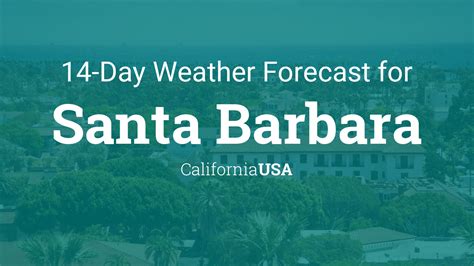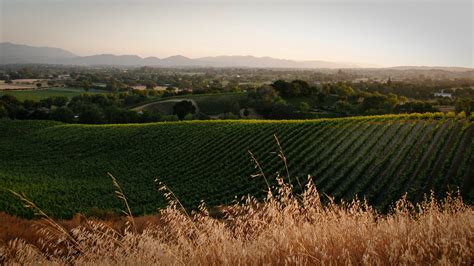The picturesque city of Santa Barbara, nestled between the Santa Ynez Mountains and the Pacific Ocean, boasts a Mediterranean climate that is characterized by mild, wet winters and warm, dry summers. As we delve into the forecast for this enchanting city, it’s essential to understand the factors that influence its climate, from the oceanic currents to the topographical features of the surrounding landscape.
Seasonal Overview The city’s climate can be broadly categorized into four distinct seasons, each with its unique charms and weather patterns.
- Winter (December to February): This is the coolest and wettest period, with average temperatures ranging from 45°F (7°C) to 60°F (15°C). The rainfall during these months is moderate, with an average of 12 inches (300 mm), making it the perfect time for outdoor activities like hiking and exploring the scenic trails of the Santa Ynez Mountains.
- Spring (March to May): As the winter months give way to spring, Santa Barbara experiences a gradual warming, with average temperatures increasing to between 50°F (10°C) and 65°F (18°C). This season is marked by mild rainfall, with an average of 6 inches (150 mm), and is ideal for visiting the city’s famous beaches, such as East Beach and Leadbetter Beach.
- Summer (June to August): The summer months bring warm, dry weather, with average temperatures ranging from 60°F (15°C) to 75°F (24°C). This is the peak tourist season, with visitors flocking to enjoy the city’s beautiful beaches, outdoor recreation opportunities, and cultural events like the Santa Barbara Bowl.
- Autumn (September to November): As summer gives way to autumn, the temperatures cool slightly, with averages ranging from 55°F (13°C) to 70°F (21°C). The rainfall during this period is minimal, making it an excellent time for outdoor activities like biking, surfing, and whale watching.
Climate Trends and Patterns Santa Barbara’s climate is influenced by its proximity to the Pacific Ocean and the Santa Ynez Mountains. The city experiences a phenomenon known as “June Gloom,” where a layer of marine fog rolls in during the late spring and early summer, cooling the temperatures and reducing the amount of sunlight. This phenomenon is particularly pronounced in the coastal areas, where the fog can linger until mid-morning.
In addition to the June Gloom, Santa Barbara is also susceptible to heatwaves during the summer months, particularly in the inland areas. These heatwaves can bring temperatures above 90°F (32°C), making it essential for visitors to stay hydrated and take necessary precautions.
Weather Extremes While Santa Barbara’s climate is generally mild, the city is not immune to extreme weather events. The region is prone to droughts, which can have significant impacts on the local ecosystem and water supply. In recent years, the city has experienced several severe droughts, including the 2012-2016 drought, which was one of the most severe on record.
In addition to droughts, Santa Barbara is also susceptible to wildfires, particularly during the dry summer months. The city has experienced several devastating wildfires in recent years, including the 2017 Thomas Fire, which was one of the largest wildfires in California’s history.
Forecasting Tools and Resources For those planning a visit to Santa Barbara, there are several forecasting tools and resources available to help you prepare for your trip. The National Weather Service (NWS) provides detailed forecasts, warnings, and conditions for the area, including temperature, precipitation, and wind predictions.
In addition to the NWS, there are several online resources available, including weather apps and websites, that provide real-time weather updates and forecasts. Some popular options include AccuWeather, Weather.com, and the Santa Barbara County Office of Emergency Management.
What is the best time to visit Santa Barbara?
+The best time to visit Santa Barbara depends on your preferences. If you enjoy mild weather and outdoor activities, spring and autumn are ideal. If you prefer warmer weather and don't mind crowds, summer is the peak tourist season. Winter is the coolest and wettest period, but it's still a great time to explore the city's indoor attractions and enjoy outdoor activities like hiking.
How does the ocean influence Santa Barbara's climate?
+The Pacific Ocean plays a significant role in moderating Santa Barbara's climate. The ocean's cool waters help keep temperatures mild, especially during the summer months. The ocean also contributes to the city's rainfall, with most of the precipitation coming from the west. Additionally, the marine layer, which is a layer of cool air that forms over the ocean, can bring fog and cool temperatures to the coastal areas.
What are some popular outdoor activities to enjoy in Santa Barbara?
+Santa Barbara offers a wide range of outdoor activities, including hiking, biking, surfing, and whale watching. The city has several beautiful beaches, such as East Beach and Leadbetter Beach, which are perfect for swimming, sunbathing, and beach volleyball. The surrounding mountains and hills also offer plenty of opportunities for hiking and horseback riding.
In conclusion, Santa Barbara’s forecast is a complex and dynamic entity, influenced by a variety of factors, including the ocean, topography, and climate trends. By understanding these factors and using the available forecasting tools and resources, visitors can make informed decisions about their trip and enjoy all that this beautiful city has to offer. Whether you’re interested in outdoor activities, cultural events, or simply exploring the city’s charming streets and architecture, Santa Barbara has something for everyone.



